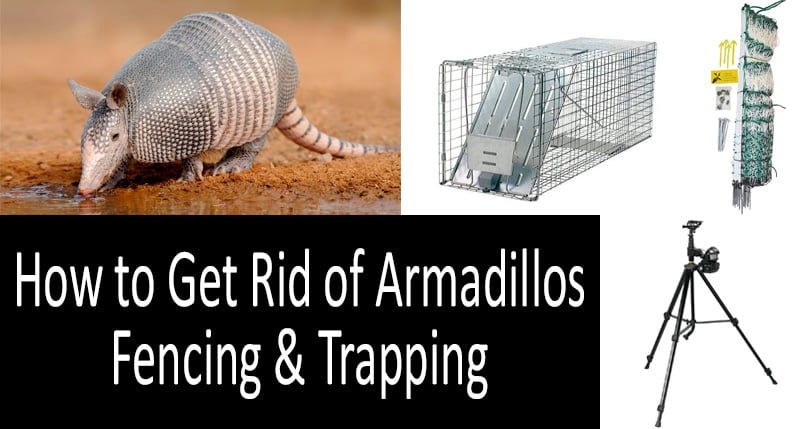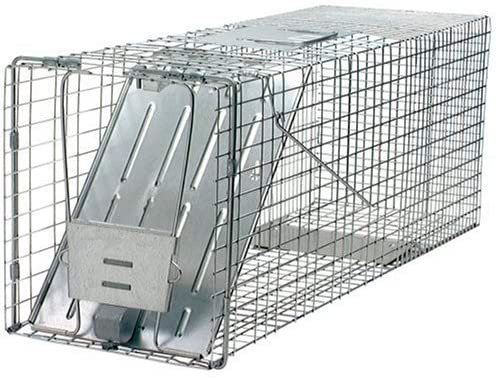Why should you get rid of armadillos? They dig deep trenches looking for grubs and worms, which are their primary source of food. Some burrows are as large as 10 inches in diameter and can cause significant damage to your lawn or garden. However, the damage they cause to your yard is not the only reason for taking protective measures. You might have heard stories about how armadillos spread leprosy. This is true. There is enough scientific evidence proving that armadillos can transmit the disease to humans when they have physical contact.
So how to get rid of armadillos efficiently? These animals are not easy to lure into a trap while repellents often have the opposite effect. That is why building a fence is the most robust approach. But it’s not that simple. You should choose the right fence and install it properly — sink it 2 feet deep into the ground. The fence that will most effectively keep armadillos away is an electric one as it will discourage the intruders from trying to enter your property. The RentACoop Poultry Netting Electric Fence is the best option that is designed to deter predators like wolves and raccoons. Measuring 4 feet in height and 13 feet in length, the fence comes with pre-fastened double-spike posts and is made from sturdy material.
Now, let’s see what are the best methods you can use to get rid of armadillos.
Exclusion: Install an Armadillo Fence Around Your Property
Creating physical barriers is the simplest and most effective way to keep armadillos away from your yard. Prevention is key to success in pest control and building fences is the surest way to save your garden from armadillos’ digging. This is particularly helpful for those who need to protect large-sized yards.
That said, not every fence is suitable for this purpose. So what are the main features of a reliable armadillo fence?
- Height Requirements. Since these animals are poor climbers but excellent diggers, the fence does not necessarily have to be tall. It is much more important that the structure goes deep enough into the earth so that armadillos could not dig under it. The specific recommendations vary but we advise you to install a fence at least 1.5 to 2 feet into the ground. The top part of the structure should be about 2 feet above the ground, at an angle of 45 degrees. When armadillos jump, they will not be able to climb over it.
- Fence Material. Choose metal fences, not wooden ones. While being more expensive, they are sturdy enough to prevent armadillos from entering. At the very least, you can build a fence with a wooden top and a metal bottom. or for aesthetics a barrier fence with a wooden fence lining the interior. Preventative measures needn’t detract from your homes beauty.
- The Type of Fence. If you can afford it, an electric fence is the best option for protecting your property. The only downside to electric fences is that they can harm your pets and other non-target animals. To avoid this, operating on low amperage. Such fences will jolt and frighten the animal without harming it.
In our assessment, the RentACoop Poultry Netting Electric Fence will be a perfect choice. It is made by a reputable American company, RentACoop, that rents chicken, incubators, brooders, feeders, and everything necessary for successful chicken farming. This fence is designed to prevent predators like raccoons, wolves, and bear from entering the protected zone. It is 4 feet in height and 13 feet in length, which allows you to sink the fence deep into the ground. The product is reliable as it comes with pre-fastened double-spike posts and is made from sturdy material. On top of that, it will take you no more than 15 minutes to set up this fence.
How to Trap Armadillos
If you want to catch as many armadillos as possible, set traps at the right time and in the right place. These animals live in burrows under the ground and are most active at night. Therefore, you should place your trap near their burrow in the evening and check the cage every morning. Set a trap in front of their nest exit hole or along the fence or wall in the area where the damage was discovered. Arrange two wooden planks in a V-shape so that more armadillos will get inside the trap.
What to bait an armadillo trap with? Unfortunately, no food that you can put in a cage is effective in attracting these animals. Why? The problem is with their way of getting food. Armadillos know that they need to dig to find something eatable, including worms and grubs. You may use earthworms or some spoiled fruits to attract insects, however, the bait does not actually matter much. Worse still, you risk attracting other unwanted animals like raccoons. Some experienced homeowners claim that an armadillo can be attracted by the smell of another armadillo, so they do not recommend washing the cage after catching these animals.
Now, what type of trap is best for armadillos? The best option is a live trap that is sturdy enough to withstand the strength of these animals. Besides being made from a strong material, your armadillo trap should meet certain size requirements. The perfect cage should at least 32 inches in length and 12 inches in height. Although armadillos are smaller in size, extra space will make them feel more comfortable to enter such a cage. The number of doors is another essential factor to look for in armadillo traps. Whereas one-door cage is more comfortable for larger armadillos, the two-door one will provide a higher catch rate because the animals will be able to enter the trap from either side.
The Havahart 1079 Large 1-Door Humane Animal Trap is the most popular option on the market. Measuring 32 x 10 x 12 inches in sizes, the trap is designed specifically for catching armadillos, raccoons, and cats. Its one-door design makes the trap suitable for armadillos of all sizes, leaving them no chance to escape. Made from wire mesh and galvanized steel, the cage is rust- and corrosion-resistant. This live trap is safe for animals you are going to catch because the cage edges are smoothed and will not hurt them.
Electronic Repellers for Armadillos
There is a variety of electronic deterrent devices that are designed to frighten off medium- to large-sized animals from the yard. Generally, they work by emitting ultrasound, sprinkling water or scaring intruders away with a sudden burst of light. As for the latter, light deterrents are not effective against armadillos as they have poor eyesight.
The best armadillo repellent devices are those using water as a deterrent. Most modern sprinklers are based on motion-activated technology that captures any movement in the area. Once a moving object is detected, the device activates, spraying a powerful burst of water.
A bright example of an advanced device of this type is the Orbit 62120 Garden Enforcer Motion Activated Sprinkler. The device is equipped with a 120-degree sensor with 3 modes of activation: night, day, and continuous operation. The sensor detects unwanted animals at a distance of up to 40 feet while the unit covers the area of about 1600 sq ft. The sprinkler can be easily adjusted, so you can angle it down to target armadillos. Besides, there is a feature allowing you to time watering. The unit runs on AA batteries that will be sufficient for more than 7,000 activation cycles.
Alternatively, you may choose an electronic deterrent that relies on ultrasound like the Hoont Advanced Motion Activated Ultrasonic Repeller. While the efficiency of this method is considered questionable, it is still a promising approach due to its safety and comfort features. Ultrasound is inaudible to humans but can cause anxiety in some animals that perceive high-pitched noises.
Applying Armadillo Repellent Sprays
If armadillos have not yet invaded your garden in large numbers, you may try repelling them with sprays. The most effective solutions are those based on the urine of predators such as the fox, wolf, coyote, and alligator. The trick is to create the false impression that a predator has marked the territory and, therefore, it is not safe.
Another option is using repellent sprays based on castor oil like the Liquid Fence 70167 Repellent Concentrate. They don’t affect armadillos themselves but the food they eat. By penetrating the ground, the repellent makes worms and grubs — what armadillos like to eat — unpalatable, discouraging armadillos from further digging your garden. You may also spray their burrows with a castor oil repellent to create a nasty odor inside and try to drive them away from the place.
Sprinkling mothballs — small balls containing pesticide — may also help, but this solution is believed to be unsafe and of little efficiency. Not only are they toxic to humans and pets, but they also evaporate quickly when applied outdoors.
The Shake Away 5006258 Fox Urine Granules will work great against armadillos. Why? When choosing between liquid sprays and granules for outdoor application, opt for the latter. This is the best option because this repellent comes in granules, evaporates more slowly in the open air and is longer-lasting. Moreover, these granules are porous and water-resistant, meaning they will not lose their potency after rain. This solution is based on fox urine (5%) to create the illusion that this predator is somewhere around.
Rules on How to Get Rid of Armadillos: Effectiveness Based on Scientific Evidence
Expert Opinion: Mike Shaw, Biologist, Oklahoma Department of Wildlife Conservation

Mike Shaw, Biologist, Oklahoma Department of Wildlife Conservation
Mike Shaw is a biologist at the Oklahoma Department of Wildlife Conservation. He joined the department when he was studying in a graduate school at Oklahoma State University. His area of interest lies in managing the deer herd in the region.
“Armadillos have a fairly small home range. Normally, they do not get over about 10 acres and usually, it is much less than that. Primarily, you would want to look for holes that would be 7 to 8 inches in diameter and they would generally be located at the base of a rock pile or compost pile… Probably the most effective (bait for traps) is natural food. If you could get crickets or earthworms or that sort of thing. Put them in a small canister and dig a small hole under the trap and make the container level with the soil and that way it would not interfere with the treadle mechanism for springing the trap”.
When it comes to trapping armadillos, this method works but not always. Scientists from Texas A&M AgriLife Extension Service-Wildlife Services note that these animals are unpredictable, which makes them difficult to catch. Anyway, it is important to place your trap properly. They recommend setting them up in trails along fences, close to buildings or in front of their burrows. Robert Pierce, Extension Wildlife Specialist at the University of Missouri, advises using 10-by-10-by-32-inch live traps to catch these animals.
Dr. Roy Beckford, Extension Director for Lee County, suggests treating the yard with insecticides and setting traps. At the very least, you may resort to shooting. Please refer to your state’s hunting and trapping regulations. Does armadillo repellent work? Well, you can apply it in a number of ways. Dr. Beckford mentions creating barriers and treating the soil with insecticides to restrict armadillos’ food sources, which are the primary reason for their visiting your garden. However, he notes, this may have the opposite effect — more intense digging in the attempt to find something eatable.
That is why Dr. Beckford recommends installing fences that are partially buried below the surface. There is one more tip from the expert: wait until armadillos leave their burrow at night and fill their shelter with mothballs and dirt. This will lead them to perceive your place as unfriendly and encourage them to leave.









